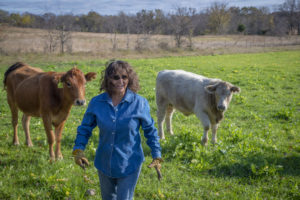
Tammy is the sole manager of 800 acres of native and improved grasses, 80 head of cattle, and three dogs.
By: Janlyn Hannah, Farm Service Agency and Mary Collier, Natural Resources Conservation Service
Tammy Higgins is a cow/calf operator in Okemah, Oklahoma, who has met cattle market, drought, and financing obstacles head-on and come out on top. Tammy is a positive, high-energy rancher who has worked hard to extend her family’s legacy.
Ranching Roots
During Tammy’s childhood, her father’s farm was home to over 500 cows, 700 yearlings, 300 feeder pigs, and 400 sheep. A self-proclaimed cattlewoman “since the day I was born,” Tammy has been checking and feeding livestock – and driving tractors and farm trucks – for as long as she can remember.
Tammy earned her degree in ranch management from Eastern Oklahoma State University before returning to the family farm. Today, Tammy is the sole manager of 800 acres of native and improved grasses, 80 head of cattle, and three dogs with big personalities.
“For me,” Tammy reflects on her farm proudly, “it’s not a way of living, but a way of life.”
Building the Herd
Building her herd and keeping the farm in her family hasn’t always been easy. Tammy jokes that little disruptions like multi-year droughts and low cattle prices have tested her patience and her pocketbook.
Tammy’s first experience with the Okfuskee County USDA Service Center occurred as a child when she’d visit the office alongside her father. As an adult running her own operation, she appreciates the working relationships she has built over the years with her local Farm Service Agency and Natural Resources Conservation Service employees.
Tammy first worked with USDA in 1974, when she obtained a farm operating loan. Tammy credits the operating loan with keeping her operation going. A point of excitement and pride for Tammy was being financially stable enough to pay off that loan and continue growing her operation.
Protecting and Maintaining

Tammy has worked with FSA and NRCS to strengthen her operation.
Tammy protects her Bermuda and native grasses from any potential losses by covering them through FSA’s Noninsured Crop Disaster Assistance Program. NAP provides financial assistance to producers of noninsurable crops, like pasture and rangeland, to protect against natural disasters that result in lower yields, crop losses, or prevents crop planting. In times of drought, she turned to FSA’s Livestock Forage Disaster Program, which compensates livestock producers who have suffered grazing losses.
Through NRCS Environmental Quality Incentives Program brush management practices, Tammy has removed invasive brush and other species in her pastures. EQIP provides financial and technical assistance to producers to address natural resource concerns. She also uses NRCS’s Conservation Stewardship Program, designed to help producers maintain and improve existing conservation systems and adopt additional conservation practices to address priority resource concerns.
More Information
USDA offers a variety of risk management, disaster assistance, loan, and conservation programs to help agricultural producers in the United States weather ups and downs in the market and recover from natural disasters as well as invest in improvements to their operations. Learn about additional programs.
For more information about USDA programs and services, contact your local USDA service center.
Join the Conversation
For the digital version of this blog, visit #FridaysOnTheFarm
Follow the #FridaysOnTheFarm story series and other news you can use on farmers.gov and our social media channels: Twitter, Instagram, YouTube, Flickr, and Facebook.
Photo Credit: Preston Keres, USDA





